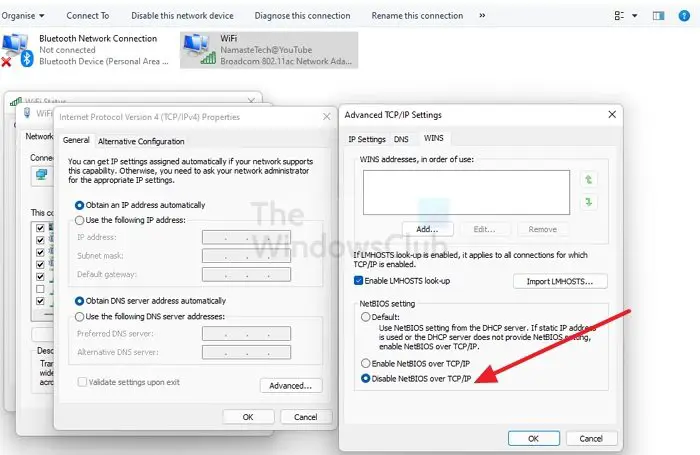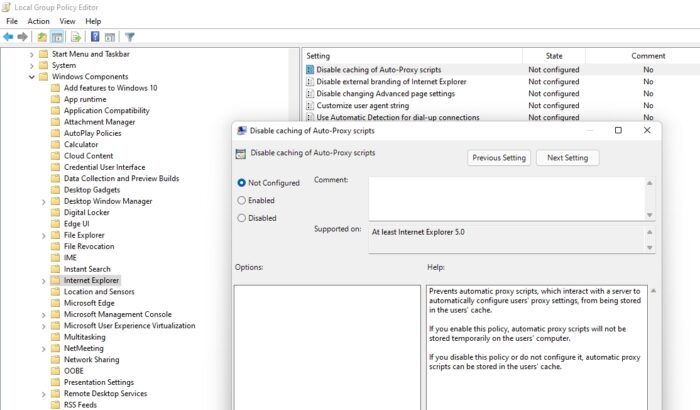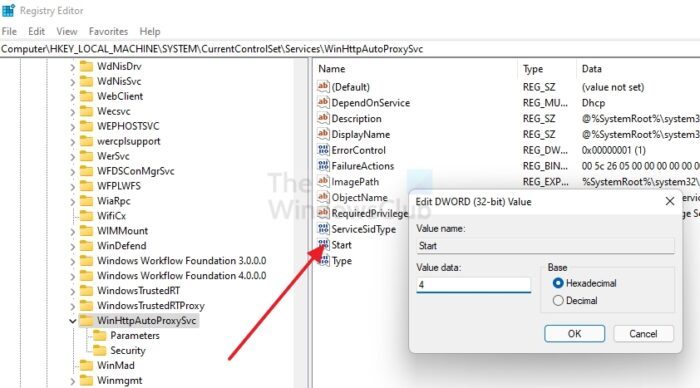Web Proxy Auto-Discovery or WPAD allows apps such as browsers to discover the location of a web URL or a file on the internet. It was introduced in 1999, letting browsers know which proxy to use. So if you are in a corporate environment with its proxy, the browser can figure out that using the auto-discovery. However, the protocol is not safe anymore and can easily be hijacked. So you should disable Web Proxy Auto-Discovery (WPAD) in Windows 11/10.

How to disable Web Proxy Auto-Discovery (WPAD) in Windows 11/10
You can disable it using the following methods, but you must use an admin account.
- Disable WPAD by disabling WINS/NetBT name resolution
- Stop WPAD using a host file entry
- Group Policy Editor
- Registry method
While Group Policy Editor is not available for Windows Home, you can install it using an easy guide. If not, then you can use the Registry method.
1] Disable WPAD by disabling WINS/NetBT name resolution

- Open Settings and navigate to Network & Internet > Advanced network settings
- Click on More network adapter options to open the classic control panel
- Next, double-click on the network adaptor you use to connect to the internet
- In the network properties window, click on the Properties button
- In the next window, double click on Internet Protocol (TCP/IP)
- Click Advanced, and then switch to the WINS tab,
- Then check the radio button next to Disable NetBIOS over TCP/IP
Restart the PC to apply the change.
2] Stop WPAD using a host file entry
You can also disable it using the HOST file.
- Open Windows Explorer using Win + E
- Go to %systemdrive%\Windows\System32\Drivers\etc\hosts
- Create the following entry for WPAD in the host file: 255.255.255.255 wpad
It will disable the WPAD usage on your PC.
3] Group Policy Editor

- Open Run prompt (Win + R), type gpedit.msc, and then press the Enter key
- Navigate to the following in the GPO
User Configuration\Administrative Templates\Windows Components\Internet Explorer
- Locate the policy with the name Disable caching of Auto-Proxy scripts.
- Double click to open, and then
Click Enable, and then click OK.
4] Make changes via Registry
Since we are modifying the registry here, make sure to take a backup or create a System Restore point. You can always bring the system back to a working state if something goes wrong.

- Open the Run prompt, type regedit, and press Shift + Enter to launch the registry editor.
- Navigate to the following path
Computer\HKEY_LOCAL_MACHINE\SYSTEM\CurrentControlSet\Services\WinHttpAutoProxySvc
- Double click on Start REG_DWORD to get into edit mode
- Set the value as 4
- Once done, close the registry editor and then reboot for changes to take place.
B00ya adds in the comments: Starting in Windows Server 2019 and Windows 10, version 1809, you can disable WPAD by setting a DWORD value for the following registry subkey to 1:
HKLM\SOFTWARE\Microsoft\Windows\CurrentVersion\Internet Settings\WinHttp\DisableWpad
I hope the post was easy to follow, and you were able to disable Web Proxy Auto-Discovery (WPAD) in Windows 11/10.
What does Auto proxy Discovery do?
The process of automatic proxy detection involves the identification of a Web proxy server by the system, which is then used to send requests on behalf of the client. This feature is commonly referred to as Web Proxy Auto-Discovery (WPAD).
Read: Error Writing Proxy Settings, Access is denied
When should I use proxy?
Proxy servers are an easy way to improve speeds and conserve bandwidth on a network. Proxy servers can free up valuable bandwidth on busy networks by compressing traffic, caching files and web pages accessed by multiple users, and stripping ads from websites.
Is a proxy the same as a VPN?
A VPN and proxy server both conceal your IP address. But a VPN will also encrypt the data you send and receive, something that a proxy server doesn’t do. If you are already using a VPN, connecting to a website or app through a proxy server would be unnecessary.
Does Windows have a built-in proxy?
No. It doesn’t offer any built-in proxy, but it can detect the proxy available on the PC using the Web Proxy Auto-Discovery Protocol (WPAD) when the Automatically detect settings option is enabled.
Leave a Reply